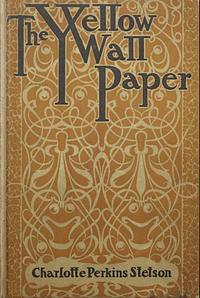Take a photo of a barcode or cover
dark
mysterious
challenging
dark
emotional
mysterious
reflective
tense
fast-paced
Plot or Character Driven:
Character
Strong character development:
N/A
Loveable characters:
N/A
Diverse cast of characters:
N/A
Flaws of characters a main focus:
Yes
reflective
sad
fast-paced
Plot or Character Driven:
Character
emotional
mysterious
fast-paced
dark
emotional
mysterious
tense
fast-paced
Plot or Character Driven:
Plot
Strong character development:
Complicated
Loveable characters:
Complicated
Diverse cast of characters:
Complicated
Flaws of characters a main focus:
Yes
el feminismo y odiar a los hombres son dos cosas completamente diferentes. yo apoyo ambas
Plot or Character Driven:
Character
Wow.
This short story is even more amazing than I expected it to be. I’d read about it a while ago in The Female Malady by Elaine Showalter, which piqued my interest, as she waxes lyrical about the story. I wasn’t going to review anything at all this month, but I needed to write and I got way too excited about this short story and needed to talk about it!
I’ve been working on this kind of thing, including the eminent 19th Century American psychiatrist Silas Weir Mitchell’s infamous “rest cure”. This is the same rest cure which Virginia Woolf was subjected to numerous times in her life, of which the fear of having to undergo again factored into her decision to commit suicide. It is also the rest cure that Septimus Warren Smith chooses suicide to escape from in Woolf’s Mrs. Dalloway. Yeah, it was that bad.
The idea was to isolate the patient entirely, giving them nothing to eat but litre upon litre of milk, with the occasional bit of rare meat. The patient was not allowed to write- a condition which severely affected both Perkins Gilman and Woolf, as well as the protagonist in this story. They were not allowed exercise, and were on a strict regime of bromides, eating, sleeping and doing absolutely nothing more. The doctors would usually visit once a week, but the patient was not allowed to advocate for their own sanity. Essentially, for many women, this was an utterly infantilising experience, and one which (as in this story) often did much more harm than good.
“…you invoke proportion; order rest in bed; rest in solitude; silence and rest; rest without friends, without books, without messages; six months rest; until a man who went in weighing seven stone six comes out weighing twelve” ( Virginia Woolf, [b:Mrs. Dalloway|14942|Mrs. Dalloway|Virginia Woolf|https://d.gr-assets.com/books/1319710256s/14942.jpg|841320], pg. 108)
I would absolutely go crazy under those conditions. Who thought wallpaper like this was a good idea anyway?!
This short story can be read on multiple levels, though it invokes the double in all the ones I can think of. The unnamed female narrator begins to believe that there is a woman trapped or hiding behind the arabesque design of the wallpaper, and becomes fixated on letting her out. Her fixation on the grotesque pattern of the wallpaper grows more and more manic as she is incarcerated in the room. The husband, John, a doctor, essentially traps her in the “nursery” which is far more like a prison cell for a mentally deranged person, has pushed his belief of what is and isn’t acceptable behaviour or thoughts for a woman, and has imprisoned her. He, being a man, and being her husband, has the ultimate power in their relationship. He even has medical power over her, giving him the ability to lock his wife in a room with barred windows, rings on the walls, a bed with canvas mattress nailed to the ground (complete with bite marks all over it) and this yellow wallpaper that he hopes will give him what he desires- an infantilised, passive wife. Hell, even him calling the room the “nursery” points towards the ideal of passive, childlike womanhood. A man could very easily silence a woman who had become too independent, too imaginative or too outspoken by declaring her to be “hysterical”, and this is exactly what John does in this story.
Charlotte Perkins Gilman was placed into a rest home by her doctor, Weir Mitchell, because she suffered from bouts of depression. The experience nearly sent her into a state of madness she had never anticipated.
“[I] obeyed these directions for some three months, and came so near to the borderline of utter mental ruin that I could see over.
Then, using the remnants of intelligence that remained…I cast the noted specialist’s advice to the winds and went to work again… ultimately recovering some measure of power. “ ([a:Elaine Showalter|26655|Elaine Showalter|https://d.gr-assets.com/authors/1424019863p2/26655.jpg][b:The Female Malady: Women, Madness and English Culture 1830-1980|342823|The Female Malady Women, Madness and English Culture 1830-1980|Elaine Showalter|https://d.gr-assets.com/books/1391394113s/342823.jpg|52337], pg. 140)
The protagonist of this story is not so lucky, though she does triumph over her captors in her own small way- she claims her freedom from them. She proves that her husband has no idea what’s best for her, and his threats and coercions have no power. His repression and her own anger towards him has rendered her incapable of asserting herself in any other way. The protagonist has rebelled against the Victorian patriarchy and a society intent upon silencing women, especially women who desire independence, by calling them “mad”.
This is only a very short story, which I read in the very gorgeous Penguin Little Black Classics edition, however, it is available through Project Gutenberg, which is always nice. It is an extremely good read, and one that will stay with me for a very long time. I am slowly but surely coming around to the art of the short story, which has eluded me for quite a long time. Hopefully, in the future, my heart won’t sink when I read that a book I’ve been interested in is a collection of short stories!
As for Weir Mitchell, Perkins Gilman got her own back. She sent him a copy of The Yellow Wall-Paper, which he ignored, but he “admitted to friends that he had altered his treatment of neurasthenics” after having read it. Who wants to give a mere woman the satisfaction of having hit you for six? Not an eminent Victorian psychiatrist, that’s for sure.
This short story is even more amazing than I expected it to be. I’d read about it a while ago in The Female Malady by Elaine Showalter, which piqued my interest, as she waxes lyrical about the story. I wasn’t going to review anything at all this month, but I needed to write and I got way too excited about this short story and needed to talk about it!
I’ve been working on this kind of thing, including the eminent 19th Century American psychiatrist Silas Weir Mitchell’s infamous “rest cure”. This is the same rest cure which Virginia Woolf was subjected to numerous times in her life, of which the fear of having to undergo again factored into her decision to commit suicide. It is also the rest cure that Septimus Warren Smith chooses suicide to escape from in Woolf’s Mrs. Dalloway. Yeah, it was that bad.
The idea was to isolate the patient entirely, giving them nothing to eat but litre upon litre of milk, with the occasional bit of rare meat. The patient was not allowed to write- a condition which severely affected both Perkins Gilman and Woolf, as well as the protagonist in this story. They were not allowed exercise, and were on a strict regime of bromides, eating, sleeping and doing absolutely nothing more. The doctors would usually visit once a week, but the patient was not allowed to advocate for their own sanity. Essentially, for many women, this was an utterly infantilising experience, and one which (as in this story) often did much more harm than good.
“…you invoke proportion; order rest in bed; rest in solitude; silence and rest; rest without friends, without books, without messages; six months rest; until a man who went in weighing seven stone six comes out weighing twelve” ( Virginia Woolf, [b:Mrs. Dalloway|14942|Mrs. Dalloway|Virginia Woolf|https://d.gr-assets.com/books/1319710256s/14942.jpg|841320], pg. 108)
I would absolutely go crazy under those conditions. Who thought wallpaper like this was a good idea anyway?!
This short story can be read on multiple levels, though it invokes the double in all the ones I can think of. The unnamed female narrator begins to believe that there is a woman trapped or hiding behind the arabesque design of the wallpaper, and becomes fixated on letting her out. Her fixation on the grotesque pattern of the wallpaper grows more and more manic as she is incarcerated in the room. The husband, John, a doctor, essentially traps her in the “nursery” which is far more like a prison cell for a mentally deranged person, has pushed his belief of what is and isn’t acceptable behaviour or thoughts for a woman, and has imprisoned her. He, being a man, and being her husband, has the ultimate power in their relationship. He even has medical power over her, giving him the ability to lock his wife in a room with barred windows, rings on the walls, a bed with canvas mattress nailed to the ground (complete with bite marks all over it) and this yellow wallpaper that he hopes will give him what he desires- an infantilised, passive wife. Hell, even him calling the room the “nursery” points towards the ideal of passive, childlike womanhood. A man could very easily silence a woman who had become too independent, too imaginative or too outspoken by declaring her to be “hysterical”, and this is exactly what John does in this story.
Charlotte Perkins Gilman was placed into a rest home by her doctor, Weir Mitchell, because she suffered from bouts of depression. The experience nearly sent her into a state of madness she had never anticipated.
“[I] obeyed these directions for some three months, and came so near to the borderline of utter mental ruin that I could see over.
Then, using the remnants of intelligence that remained…I cast the noted specialist’s advice to the winds and went to work again… ultimately recovering some measure of power. “ ([a:Elaine Showalter|26655|Elaine Showalter|https://d.gr-assets.com/authors/1424019863p2/26655.jpg][b:The Female Malady: Women, Madness and English Culture 1830-1980|342823|The Female Malady Women, Madness and English Culture 1830-1980|Elaine Showalter|https://d.gr-assets.com/books/1391394113s/342823.jpg|52337], pg. 140)
The protagonist of this story is not so lucky, though she does triumph over her captors in her own small way- she claims her freedom from them. She proves that her husband has no idea what’s best for her, and his threats and coercions have no power. His repression and her own anger towards him has rendered her incapable of asserting herself in any other way. The protagonist has rebelled against the Victorian patriarchy and a society intent upon silencing women, especially women who desire independence, by calling them “mad”.
This is only a very short story, which I read in the very gorgeous Penguin Little Black Classics edition, however, it is available through Project Gutenberg, which is always nice. It is an extremely good read, and one that will stay with me for a very long time. I am slowly but surely coming around to the art of the short story, which has eluded me for quite a long time. Hopefully, in the future, my heart won’t sink when I read that a book I’ve been interested in is a collection of short stories!
As for Weir Mitchell, Perkins Gilman got her own back. She sent him a copy of The Yellow Wall-Paper, which he ignored, but he “admitted to friends that he had altered his treatment of neurasthenics” after having read it. Who wants to give a mere woman the satisfaction of having hit you for six? Not an eminent Victorian psychiatrist, that’s for sure.
adventurous
dark
emotional
mysterious
fast-paced
Plot or Character Driven:
Character
Strong character development:
Complicated
Loveable characters:
Complicated
Diverse cast of characters:
No
Flaws of characters a main focus:
Yes







